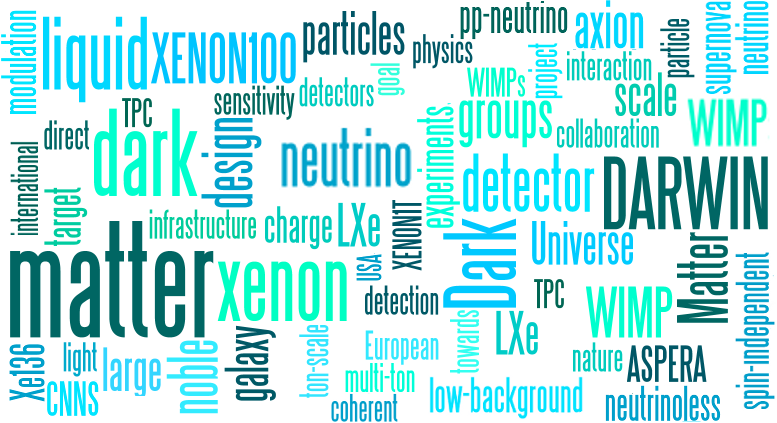
 |
the DARWIN project |
|||
| :: internal :: |

|
DARWIN: dark matter wimp search with liquid xenonOne of the most exciting topics in physics today is the question about dark matter which might be made from Weakly Interacting Massive Particles (WIMPs). These could be detected directly by their collisions with nuclei in underground experiments and such a discovery would be a milestone in physics. However, since the expected signal rates are much lower than one interaction per kg of target material and year, large-mass detectors with ultra-low backgrounds are necessary ingredients of any experiment aiming for the discovery of WIMPs. Liquid Xenon DetectorsResults from liquid xenon detectors have demonstrated over the last years that they are the most promising technology to push the sensitivity of direct WIMP searches far beyond existing limits. With its high charge and a light yield for nuclear recoils, which are the expected signature from WIMP-nucleon scattering, liquid xenon (LXe) is an excellent WIMP targets and can be scaled up to large detector masses rather easily. Dual-phase noble liquid Time Projection Chambers (TPC) are large, self-shielding, homogeneous and position sensitive WIMP detectors. The relative size of the charge and light signals provides efficient discrimination against electronic recoil background events, at the DARWIN-scale mainly from neutrinos, and the good spatial resolution allows for the rejection of the neutron background based on the event multiplicity. The XENON10 and XENON100 experiments at the Gran Sasso Underground Laboratory (LNGS) were successful demonstrators of dual-phase liquid xenon TPCs. The XENON collaboration is currently operating the first dual-phase liquid xenon TPC with a ton-scale target: XENON1T features a total mass of about 3.5 tons with an instrumented target mass of 2.0 tons. The detector works very stable over large time-scales and is the most senstitive dark matter detector to-date. The update phase of this detector, XENONnT, will feature a 3x larger target mass and an even lower background. The DARWIN project can be seen as the culmination of this path, with a sensitivity goal which is a factor 100 better than XENON1T. This will allow exploring the entire accessible WIMP parameter space, which is eventually limited by irreducible neutrino backgrounds, as illustrated by the Figures below for spin-independent WIMP-nucleon and spin-dependent WIMP-neutron interactions. The Path to a multi-ton scale Detector...An exposure around 200 txy and the very low background conditions are required to reach the design sensitivity. The DARWIN baseline design foresees simultaneous charge and light readout in a dual-phase TPC of 40 t xenon target, as illustrated in the Figure below. R&D on alternative approaches and new detector geometries and sensors is still being actively perfomed. Others fields of ongoing research towards DARWIN are covering cryostat and shield design, charge and light readout, purification and storage of the noble liquids, high voltage systems required for charge drift and uniform field, ultra-low radioactivity materials and shields, active background reduction by target purification, and the underground infrastructure and safety aspects. This calls for a coordinated R&D and detector design effort among the many groups involved in the project, with a clear added value from close collaboration and interchange of ideas, information and results.
|
|
:: modified 22.09.2020 ::
|